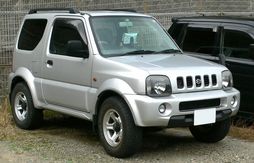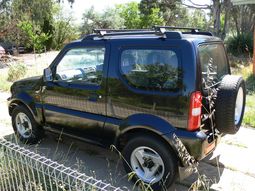The History Of Suzuki Jimny WIDE

The Suzuki Jimny is a small four wheel drive built by the Japanese manufacturer Suzuki. Three body styles are available: a metal top, a hard top and soft top. The Jimny replaced the popular Sierra/ Samurai model in most markets in 1999, though its predecessor remains in limited production in some regions. The Jimny (3rd generation) was equipped with a newly designed 1.3L 16-valve four-cylinder electronically fuel injected engine or a 1.5 Diesel engine (again Market specific). A ladder type chassis and a dual ratio transfer case is standard, unlike many competing compact 4WDs which lack a low range, and are strictly in the crossover category.
The Jimny's vacuum-locking hubs allow the vehicle to be shifted from 2WD to 4WD while travelling at up to 100km/ h (62mph). Shifting to low range requires the vehicle to be stopped, but there is no need to exit the vehicle. Newer Jimnys feature electronic "push-button" selectable four-wheel drive.
The Jimny features large windows, giving excellent visibility, apart from a rather serious blind spot caused by the oversized "B" pillar. The large amount of glass also creates a greenhouse effect, and the Jimny comes with air conditioning as a standard feature in some regions.
Two models of the Jimny are available in some markets, the standard hard top, and a canvas roofed "Cabrio" version. Both models come in JX and JLX specifications. These are fairly standard designations across the Suzuki off road range, with the JLX being the fully-optioned "luxury" version. In the case of the Jimny, the JLX adds roof rails, power steering, power windows, electronically adjustable exterior mirrors, and several interior comfort improvements. Both models are available in 5 speed manual or 4 speed automatic gearbox. There is also a 2WD option, only available in 5 speed manual.
The history of Suzuki four wheel drive cars goes back to 1969. Suzuki bought out Hope Motor Company and produced fifteen vehicles called the HopeStar ON360. Then in 1970, they produced the first "real" Suzuki 4x4. It was called the LJ10, and it had an air cooled, 359 cc, two-stroke, in-line two-cylinder engine. 1972 saw the introduction of the LJ20. The cooling was changed from air cooling to water cooling but was not enlarged or increased in power. In 1974, Suzuki replaced the LJ20 with the LJ50, which had a larger 537 cc, two-stroke, in-line three-cylinder engine and bigger differentials.
The LJ80 was an updated version of the LJ50 with an 800 cc, four-stroke, in-line four-cylinder engine, followed by the SJ410 and SJ413. A version of the SJ413 known as the Samurai was released in the US. The series from SJ410 to SJ413 was known as the Sierra in Australia, and remained the Jimny in some markets.
The new Jimny was released in 1998, and now bears the same name in all markets. The 1998 release used the G13BB EFI engine, replaced by the M13AA EFI engine in 2001 and the M13AA VVT engine in 2005, in conjunction with some interior redesign.
First generation 1 (1970–1972)
Jimny (360 cc I2 air-cooled)
- LJ10
- Type 1 (1970: 04)
- Type 2 (1971: 02)
First generation 2 (1972–1976)
Jimny (360 cc I2 water-cooled)
- LJ20
- Type 1 (1972: 05)
- Type 2 (1974: 11)
- Type 3 (1975: 12)
First generation 3 (1976–1981)
Jimny 55 (550 cc I3)
- SJ10
- Type 1 (1976)
- Type 2 (1977)
- Type 3 (1978)
- Type 4 (1979)
Jimny 8 (800 cc I4)
- SJ20 (1977–1981)
Second generation 1 (1981–1984)
Jimny 550
- SJ30
- Type 1 (1981: 05)
- Type 2 (1983: 07) The full transistor ignition.
Jimny 1000 / SJ410
- SJ410 (1981–1998)
- SJ40 (1982–1986)
Second generation 2 (1984–1990)
Jimny 550
- SJ 30
- Type 3 (1984: 07)
- Type 4 (1986: 01) Dashpanel was changed being common to with JA51 / 71.
- Type 5 (1987: 04)
Jimny 1300
- JA51 (1984–1990)
Jimny 550 Turbo
- JA71
- Type 1 (1986: 01) Four-stroke F5A engine with Turbo charger was introduced.
- Type 2 (1987: 08)
- Type 3 (1987: 11) Intercooler was added,and the front grill was changed.
- Type 4 (1989: 04)
Second generation 3 (1990–1995)
Jimny 660
- JA11
- Type 1 (1990: 03) 55PS (54.2hp/ 40.5kW).
- Type 2 (1991: 06) Increased 58PS (57.2hp/ 42.7kW). Fan coupling was added and the front grill was changed.
- Type 3 (1992: 07) PS and AT were introduced.
- Type 4 (1994: 04) Turbo warning lamp abolished, seat belt warning lamp added.
- Type 5 (1995: 02) Improved to 64hp (48kW).
Jimny SIELLA (1300)
- JB31 (1993–1995)
Second generation 4 (1995–1998)
Jimny 660
- JA12 (SOHC: F6A) / JA22 (DOHC: K6A)
- Type 1 (1995: 11)
- Type 2 (1997: 05) Air locking hub was added
Jimny SIERRA (1300)
- JB32 (1995–1998)
Third generation (1998–)
Jimny 660
- JB23 (K6A)
- Type 1 (1998: 10)
- Type 2 (1999: 10) Position of the catalytic converter was changed.
- Type 3 (2000: 08) Hazard lamp switch was changed.
- J2 (2WD) (2001: 02)
- Type 4 (2002: 01) F-Grill, Intake were changed.
- Type 5 (2004: 10) Trim, MT / Transfar were changed.
- Type 6 (2005: 11) Head lamp optical axis adjustment was added.
Jimny Wide (1300: G13B)
- JB33 (1998–1999)
Jimny Wide / SIERRA (1300: M13A)
- JB43 (2000–)
From Wikipedia, the free encyclopedia
More About Suzuki Jimny WIDE


|